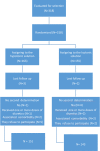Hypotonic and isotonic intravenous maintenance fluids in hospitalised paediatric patients: a randomised controlled trial
- PMID: 31206070
- PMCID: PMC6542423
- DOI: 10.1136/bmjpo-2018-000385
Hypotonic and isotonic intravenous maintenance fluids in hospitalised paediatric patients: a randomised controlled trial
Abstract
Objective: To compare the changes in serum sodium and acid/base status in patients receiving hypotonic and isotonic solutions.
Design: A randomised, controlled and double-blind clinical trial.
Setting: Department of Paediatrics in a tertiary general hospital (Hospital Universitario Austral) in Buenos Aires, Argentina.
Patients: Children between 29 days and 15 years of age who were hospitalised in the paediatric intensive care unit and general hospital between 12 January 2010 and 30 November 2016, and who required exclusively parenteral maintenance solutions for at least 24 hours.
Interventions: A hypotonic solution with 77 mEq/L sodium chloride (0.45% in 5% dextrose) and isotonic solution with 150 mEq/L (0.9% in 5% dextrose) were infused for 48 hours and were labelled.
Main outcome measure: The main outcome was to evaluate the incidence of hyponatraemia between patients treated with parenteral hydration with hypotonic or isotonic fluids. The secondary outcome was to estimate the incidence of metabolic acidosis induced by each of the solutions.
Results: The 299 patients in the present study were randomised to groups that received the hypotonic solution (n=154) or isotonic solution (n=145). The mean serum sodium concentration measurements at 12 hours were 136.3±3.9 mEq/L and 140.1±2.3 mEq/L in the hypotonic and isotonic groups, respectively, with a hyponatraemia incidence of 8.27% (n=12) and 18.8% (n=29) (p<0.001). At 24 hours, 12.4% (n=18) of the isotonic group had developed hyponatraemia compared with 46.1% (n=71) of the hypotonic group (p<0.001). The mean serum sodium concentration measurements were 134.4±5.6 and 139.3±3.1, respectively. No patient developed hypernatraemia (serum sodium concentrations >150 mEq/L) or other adverse outcomes. The relative risk in the hypotonic group was 3.7 (95% CI 2.3 to 5.9), almost four times the risk of developing hyponatraemia than those who received isotonic fluids. There were also no significant differences between the groups with regard to the development of metabolic acidosis. Hypotonic solution, age <12 months and postoperative abdominal surgery were risk factors associated with hyponatraemia.
Conclusions: The incidence of iatrogenic hyponatraemia was greater with the administration of hypotonic fluids compared with that of isotonic fluids. There were no significant differences in the incidence of metabolic acidosis between the groups.
Keywords: general paediatrics; intensive care; metabolic.
Conflict of interest statement
Competing interests: None declared.
Figures
Similar articles
-
A prospective trial comparing isotonic with hypotonic maintenance fluids for prevention of hospital-acquired hyponatraemia.Paediatr Int Child Health. 2016 Aug;36(3):168-74. doi: 10.1179/2046905515Y.0000000047. Paediatr Int Child Health. 2016. PMID: 26212672 Clinical Trial.
-
Comparison of isotonic and hypotonic intravenous maintenance fluids: a randomized clinical trial.JAMA Pediatr. 2015 May;169(5):445-51. doi: 10.1001/jamapediatrics.2014.3809. JAMA Pediatr. 2015. PMID: 25751673 Clinical Trial.
-
Isotonic versus hypotonic saline as maintenance intravenous fluid therapy in children under 5 years of age admitted to general paediatric wards: a randomised controlled trial.Paediatr Int Child Health. 2020 Feb;40(1):44-49. doi: 10.1080/20469047.2019.1619059. Epub 2019 May 29. Paediatr Int Child Health. 2020. PMID: 31138063 Clinical Trial.
-
Hypotonic intravenous solutions in children.Expert Opin Drug Saf. 2004 Jan;3(1):67-73. doi: 10.1517/14740338.3.1.67. Expert Opin Drug Saf. 2004. PMID: 14680463 Review.
-
Isotonic versus hypotonic maintenance IV fluids in hospitalized children: a meta-analysis.Pediatrics. 2014 Jan;133(1):105-13. doi: 10.1542/peds.2013-2041. Epub 2013 Dec 30. Pediatrics. 2014. PMID: 24379232 Review.
Cited by
-
Efficacy and safety of isotonic versus hypotonic intravenous maintenance fluids in hospitalized children: an updated systematic review and meta-analysis of randomized controlled trials.Pediatr Nephrol. 2024 Jan;39(1):57-84. doi: 10.1007/s00467-023-06032-7. Epub 2023 Jun 26. Pediatr Nephrol. 2024. PMID: 37365423 Free PMC article.
-
Association Between Hyponatremia and Maintenance Intravenous Solutions in Critically Ill Children: A Retrospective Observational Study.Front Pediatr. 2021 Jul 6;9:691721. doi: 10.3389/fped.2021.691721. eCollection 2021. Front Pediatr. 2021. PMID: 34295861 Free PMC article.
-
Ideal burn resuscitation: a step toward resolving the dilemma in acute flame burn management.Int J Burns Trauma. 2024 Dec 15;14(6):133-141. doi: 10.62347/SQKU5090. eCollection 2024. Int J Burns Trauma. 2024. PMID: 39850786 Free PMC article.
-
Korean Society of Nephrology 2022 Recommendations on controversial issues in diagnosis and management of hyponatremia.Kidney Res Clin Pract. 2022 Jul;41(4):393-411. doi: 10.23876/j.krcp.33.555. Epub 2022 Jul 28. Kidney Res Clin Pract. 2022. PMID: 35919925 Free PMC article.
-
Antimicrobial Functionalization of Silicone-graft-poly(N-vinylimidazole) Catheters.Molecules. 2024 May 9;29(10):2225. doi: 10.3390/molecules29102225. Molecules. 2024. PMID: 38792087 Free PMC article.
References
LinkOut - more resources
Full Text Sources


